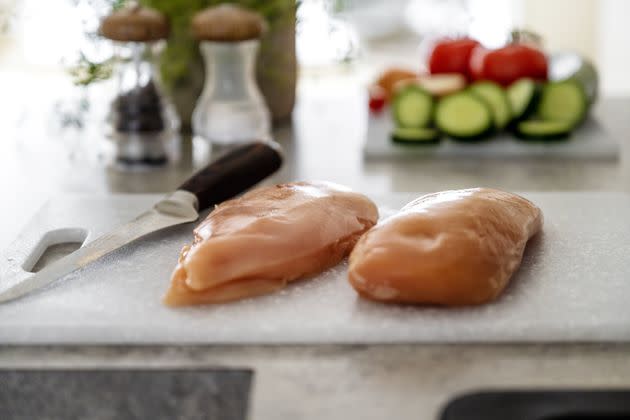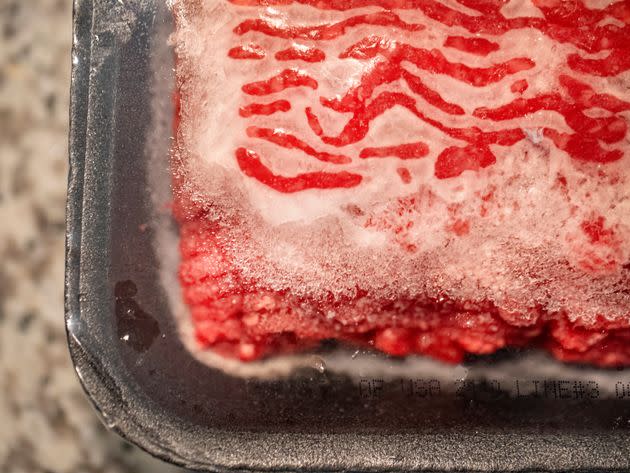The Most Common Food Safety Mistakes Home Cooks Make, According To Experts

Don't even think about washing raw chicken in your kitchen sink. It'll just spread bacteria.
When there’s a campylobacter, E. coli, or salmonella outbreak in the food supply, not only does it make headlines but companies often recall food to prevent more people from falling ill. But the same bacteria can show up in home kitchens if you’re not careful. The Centers for Disease Control and Prevention estimates that 48 million Americans get foodborne illnesses every year and 128,000 end up hospitalized.
Everyone has their favorite preparation and cooking techniques, but you may be unaware that some methods might encourage the spread of pathogens. Although you may associate food poisoning with eating in a restaurant, it’s possible to have the same bacteria lurking in your kitchen.
“Food safety is just as important at home as it is in a restaurant,” said Keith Schneider, a food safety professor in the Department of Food Science and Human Nutrition at the University of Florida. “While restaurants have a bigger impact because they serve a larger group of people, obviously you don’t want to prepare food at home and make a family member [sick] or get sick.”
According to Joshua Resnick, lead chef at the Institute of Culinary Education who is fully certified in food protection by the New York City Department of Health and Mental Hygiene, “Pathogens don’t care where they are; they will grow the same way at a home kitchen as they do in a professional kitchen. That means that everyone needs to make sure to follow proper food safety guidelines at home.”
HuffPost spoke with food safety experts on preparation and cooking methods that aren’t food-safe and what to do instead.
Neglecting To Wash Your Hands
Before you start pulling food from the fridge to prepare a meal, washing your hands should be the first thing you do. Germs can be on your hands and can easily spread to your cooking surfaces and food.
According to Mitzi Baum, CEO of STOP Foodborne Illness, a national public health nonprofit advocating for safe food and food safety culture change nationally, “The first step and first line of defense to food safety is washing your hands frequently and thoroughly with soap and water when cooking; this will reduce the incidence of cross-contamination to utensils, towels, countertops and foods.”
Washing your hands is an easy and simple prevention method to reduce pathogens. But you may need to wash your hands several times while cooking, especially if you’re handling raw meat or picking up your phone to check a recipe. “Phones and tablets can be breeding grounds for bacteria,” Resnick said. “It is super important to wash your hands before you start cooking and during the cooking process.”
Mishandling Your Cutting Boards
Slicing raw chicken or fish on a cutting board? Make sure to wash it with hot water and soap before using the same board to chop vegetables. Otherwise, you create a perfect haven for cross-contamination. “A classic example is using a cutting board to prepare meat, such as ground beef, and then you also use that same cutting board without adequate cleaning to prepare salad or [use] the knife for cutting meat or preparing poultry,” Schneider said. To prevent cross-contamination, he uses color-coded cutting boards and has separate ones for meat, poultry and fish.
Take precautions by washing utensils and items that have touched raw meat ― this can also reduce the spread of pathogens. “You must be mindful of what and how you are handling foods in the kitchen,” Baum said.
Using The Same Plate Or Utensils For Raw And Cooked Meat
You place a piece of steak on a plate, plop it on the barbecue and then, without thinking, place the cooked steak on the same plate. Hello cross-contamination.
This may seem an obvious practice to avoid, but it’s more common than you may think. “When you take burgers out to the grill, make sure you take them in on a different plate,” Schneider said.
You also want to consider any utensils that come into contact with uncooked meat. “I wash my tongs in between putting my chicken on and taking them off again,” he said.
Washing Raw Chicken
There are two teams, those who wash their poultry and those who don’t. If you’re on team “always wash your chicken,” you’re in for a surprise — it’s not a good idea. Washing meat isn’t necessary since the meat is sold as ready to cook. “Washing the bird doesn’t really significantly alter it other than removing those surface blemishes,” Schneider said.
The issue with washing chicken or turkey? It’s a wonderful way to spread bacteria and pathogens in your sink and beyond. When you wash your chicken, Schneider said, “It now increases the chance of splatter; you have what was salmonella on the bird — is now in your sink, on your faucet, on your countertop.” He said people should be sanitizing their kitchens more frequently, especially after handling raw meat.
Wondering what’s the best way to sanitize the kitchen? “You can use any household cleaners labeled for disinfection,” he said. Schneider doesn’t recommend a specific brand or type because it depends on the surface you’re cleaning. “Honestly, just soap and water is gonna get rid of a lot of the microbes,” he added.

Don't even think about letting that frozen ground beef thaw on the countertop.
Thawing Meat On The Counter
There are many ways to defrost frozen meat, but letting it thaw on the kitchen counter is not one of them. “It’s important to thaw raw meats, fish and poultry correctly because there are bacteria in and on the foods,” Resnick explained. “If these foods are held at a warm temperature (41 to 135 degrees Fahrenheit) for too long, the harmful bacteria will grow quickly.”
If you’ve had a partially thawed piece of meat, you may think it is still safe. “Even if the middle isn’t thawed, the meat on the outside is exposed to this temperature for an extended period and can make your food unsafe to eat,” Resnick said.
There are several ways to defrost meat, according to Baum: “Thaw in the refrigerator, thaw under cold running water, thaw as part of the cooking process or thaw in the microwave ONLY if it is cooked directly after thawing.” (These tips align with the Food and Drug Administration’s guidance.) And if you’re thinking, “I’ll just place the frozen meat in a bowl of water,” that’s also not a good option. Resnick explained that thawing meat in water is similar to thawing it on the counter.
Not Using A Meat Thermometer
How do you know when your chicken has been cooked thoroughly? If you’re relying on what it looks like, that won’t tell you whether it’s food-safe. “Touching foods or looking at color will not provide accurate cooking information and could lead to undercooking,” Baum said.
A more reliable method to ensure your meat is cooked sufficiently and you’re not at risk of getting sick is a meat thermometer. “Utilizing a meat thermometer to get an accurate internal temperature will minimize your risk of consuming undercooked meats, fish and poultry,” Baum explained. Maybe you only use a meat thermometer a couple of times a year to check if the turkey is cooked, but food experts recommend you put this handy gadget to use throughout the year.
“Time and temp is one of those great equalizers — if you follow instructions, most of the pathogens that we’re concerned about are going to be easily inactivated. So making sure that we reach that killed temperature and having a meat thermometer is critical,” Schneider added.
Each type of meat has a different required temperature that has been determined to reduce the levels of harmful bacteria. Check the U.S. Department of Agriculture guidelines for what is considered a safe cooking temperature.
Cooking Raw Food In The Microwave
Prefer cooking in the microwave instead of the stovetop? According to Baum, “Cooking foods in the microwave can be dangerous because foods do not cook evenly in the microwave.”
One of the main issues is it’s easy to undercook foods. “Microwave ovens have differing wattage that can influence correct cooking times and lead to undercooking,” Baum explained. “This is an issue because foods must be cooked to the proper internal temperature to ensure that harmful bacteria are killed during the cooking process.”
Educating yourself on how your microwave cooks foods can help you to not eat undercooked food. “Read and follow the instructions for microwave cooking and know the wattage of your microwave to ensure the product is cooked to the appropriate temperature,” she said.
Putting Warm Food In The Refrigerator To Cool
Do you place warm leftovers in the fridge before the food is completely cool? You may be unexpectedly putting yourself and others at risk.
Resnick explained why this is a big food safety issue. “Most people take warm leftovers, put them in a plastic Tupperware and stick it into the fridge,” he said. “However, when food sits inside the danger zone temperature range (41 to 135 degrees Fahrenheit) for an extended time, this can lead to bacteria growth that can get to dangerous levels.”
If you’re hurrying to clean up the kitchen and put away leftovers, it’s important to ensure the food has cooled down. If you don’t have time for it to cool on its own, you can help speed up the process while practicing food safety. (Just make sure it isn’t sitting out at room temperature for more than two hours!) “Food should be cooled in metal containers over ice or cut into smaller pieces so they cool down quickly,” Resnick said.

 Yahoo News
Yahoo News 